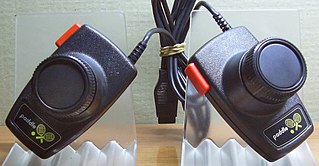
The Atari 2600 is a home video game console developed and produced by Atari, Inc. Released in September 1977 as the Atari Video Computer System, it popularized microprocessor-based hardware and games stored on swappable ROM cartridges, a format first used with the Fairchild Channel F in 1976. The VCS was bundled with two joystick controllers, a conjoined pair of paddle controllers, and a game cartridge—initially Combat and later Pac-Man. Sears sold the system as the Tele-Games Video Arcade. Atari rebranded the VCS as the Atari 2600 in November 1982 alongside the release of the Atari 5200.

The Atari 5200 SuperSystem or simply Atari 5200 is a home video game console introduced in 1982 by Atari, Inc. as a higher-end complement for the popular Atari Video Computer System. The VCS was renamed to the Atari 2600 at the time of the 5200's launch. Created to compete with Mattel's Intellivision, the 5200 wound up a direct competitor of ColecoVision shortly after its release. While the Coleco system shipped with the first home version of Nintendo's Donkey Kong, the 5200 included the 1978 arcade game Super Breakout which had already appeared on the Atari 8-bit computers and Atari VCS in 1979 and 1981 respectively.

The Atari 7800 ProSystem, or simply the Atari 7800, is a home video game console officially released by Atari Corporation in 1986 as the successor to both the Atari 2600 and Atari 5200. It can run almost all Atari 2600 cartridges, making it one of the first consoles with backward compatibility. It shipped with a different model of joystick from the 2600-standard CX40 and Pole Position II as the pack-in game. Most of the announced titles at launch were ports of 1981–1983 arcade video games.

The Atari Jaguar is a home video game console developed by Atari Corporation and released in North America in November 1993. Part of the fifth generation of video game consoles, it competed with the 16-bit Sega Genesis, the Super NES and the 32-bit 3DO Interactive Multiplayer that launched the same year. Powered by two custom 32-bit processors – Tom and Jerry – in addition to a Motorola 68000, Atari marketed it as the world's first 64-bit game system, emphasizing its 64-bit bus used by the blitter. The Jaguar launched with Cybermorph as the pack-in game, which received divisive reviews. The system's library ultimately comprised only 50 licensed games.

ColecoVision is a second-generation home video-game console developed by Coleco and launched in North America in August 1982. It was released a year later in Europe by CBS Electronics as the CBS ColecoVision.

The D-subminiature or D-sub is a common type of electrical connector. They are named for their characteristic D-shaped metal shield. When they were introduced, D-subs were among the smallest connectors used on computer systems.
The Turbo Touch 360 is a series of aftermarket third-party controllers made by Triax for the Nintendo Entertainment System, Super NES, and Sega Genesis. The Turbo Touch 360 was first shown off at the International Consumer Electronics Show in late 1993, but the controller never replaced the D-Pad in later consoles because it was reported to be overly sensitive and uncomfortable to use.

A paddle is a game controller with a round wheel and one or more fire buttons, where the wheel is typically used to control movement of the player object along one axis of the video screen. A paddle controller rotates through a fixed arc ; it has a stop at each end.

The Coleco Gemini is an Atari 2600 clone manufactured by Coleco Industries, Inc. in 1983.

Big Bird's Egg Catch is a video game for the Atari 2600 developed by Atari, Inc. and Children's Computer Workshop and published by Atari in 1983.

The Atari Flashback series are a line of dedicated video game consoles designed, produced, published and marketed by AtGames under license from Atari SA. The Flashback consoles are "plug-and-play" versions of the Atari 2600 console. They contain built-in games rather than using the ROM cartridges utilized by the 2600. Most of the games are classics that were previously released for the 2600, although some Flashback consoles include previously unreleased prototype games as well.
The Atari 2700 is a prototype home video game console that was developed by Atari, Inc. to be a wirelessly controlled version of Atari's popular Atari 2600 system. Intended for release in 1981, the 2700 was one of several planned follow-ups to the 2600, but the system was never put into full production. While It is unclear how many of these systems exist, former Atari employee Dan Kramer has stated that at least 12 consoles were made, plus extra controllers.

Space Dungeon is a multidirectional shooter released as an arcade video game by Taito in 1981. Designed and programmed by Rex Battenberg, it was available both as a conversion kit and full arcade cabinet. An Atari 5200 port was published in 1983.

Stella is an emulator of the Atari 2600 game console, and takes its name from the console's codename. It is open-source, and runs on most major modern platforms including Windows, Mac OS X, and Linux. Stella was originally written in 1996 by Bradford W. Mott, and is now maintained by Stephen Anthony.

The Atari 2600 hardware was based on the MOS Technology 6507 chip, offering a maximum resolution of 160 x 192 pixels (NTSC), 128 colors, 128 bytes of RAM with 4 KB on cartridges. The design experienced many makeovers and revisions during its 14-year production history, from the original "heavy sixer" to the Atari 2600 Jr. at the end. The system also has many controllers and third-party peripherals.
There have been a variety of Sesame Street video games released for video game platforms. Most of the Sesame Street video games were published and developed by NewKidCo.

Demons to Diamonds is a fixed shooter for the Atari 2600 produced by Atari, Inc. and released in 1982. It was programmed by Nick Turner with graphics designed by Alan Murphy. Nick Turner previously ported Super Breakout to the 2600. The manual states that the game was "primarily designed for children in the 6 to 12 age range."

The Atari joystick port is a computer port used to connect various gaming controllers to game console and home computer systems in the 1970s to the 1990s. It was originally introduced on the Atari 2600 in 1977 and then used on the Atari 400 and 800 in 1979. It went cross-platform with the VIC-20 in 1981, and was then used on many following machines from both companies, as well as a growing list of 3rd party machines like the MSX platform and various Sega consoles.

The Atari CX40 joystick was the first widely used cross-platform game controller. The original CX10 was released with the Atari Video Computer System in 1977 and became the primary input device for most games on the platform. The CX10 was replaced after a year by the simpler and less expensive CX40. The addition of the Atari joystick port to other platforms cemented its popularity. It was the standard for the Atari 8-bit computers and was compatible with the VIC-20, Commodore 64, Commodore 128, MSX, and later the Atari ST and Amiga. Third-party adapters allowed it to be used on other systems, such as the Apple II, Commodore 16, TI-99/4A, and the ZX Spectrum.
















